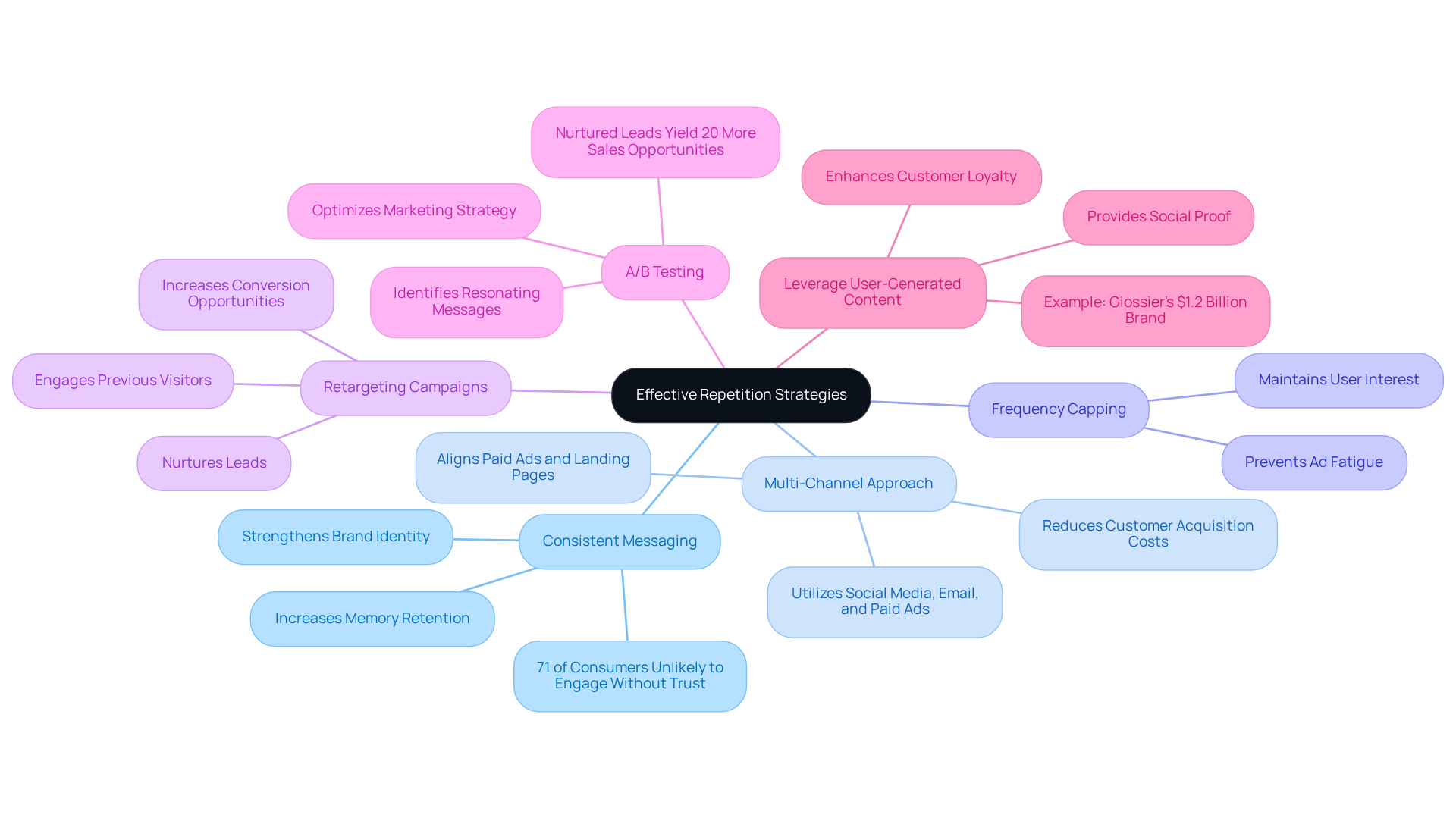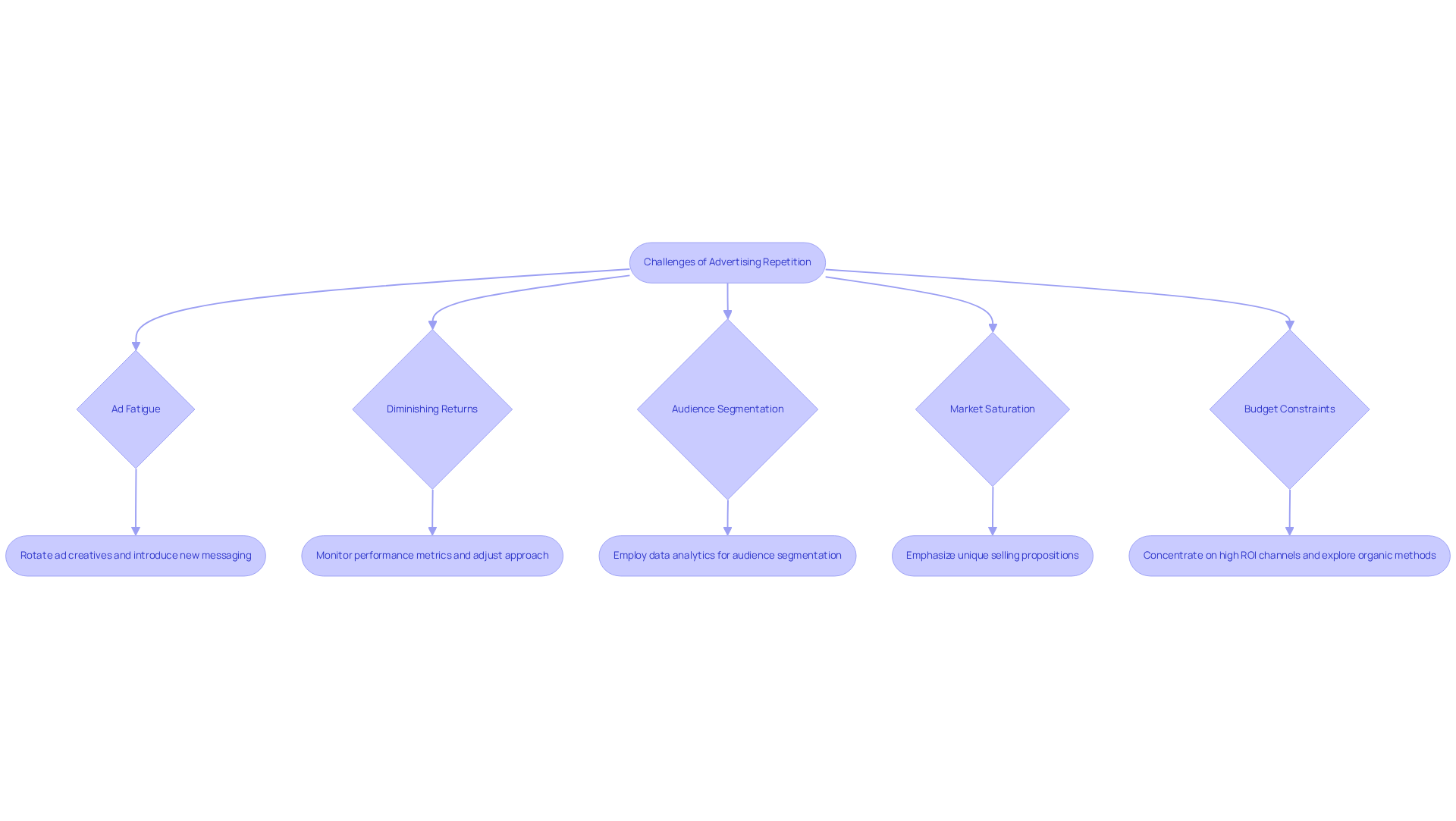
Overview
This article examines how advertising repetition can drive success for direct-to-consumer (DTC) brands by significantly enhancing brand recall, influencing purchaser behavior, and fostering long-term engagement. It outlines essential strategies such as:
- Consistent messaging
- A multi-channel approach
- Careful frequency management
These elements are crucial for building familiarity and trust while avoiding consumer fatigue. By implementing these strategies, DTC brands can create a powerful presence in the market, ensuring that their messaging resonates and remains top-of-mind for consumers.
Introduction
Advertising repetition stands as a cornerstone strategy for direct-to-consumer (DTC) brands determined to establish a lasting presence in an increasingly crowded marketplace. By leveraging the power of repeated exposure, brands can significantly enhance consumer recall, foster trust, and ultimately drive conversion rates. Yet, the challenge resides in navigating the fine line between effective repetition and consumer fatigue.
How can DTC companies master this delicate balance to maximize their advertising impact while sidestepping the pitfalls of overexposure? This article explores essential strategies that can elevate advertising repetition from a mere tactic into a formidable driver of brand success.
Understand the Importance of Advertising Repetition
In the marketing arsenal of DTC companies, advertising repetition serves as a formidable tool. It operates on the principle that advertising repetition, or repeated exposure to a product or message, enhances familiarity, which can lead to trust and ultimately, conversion. Understanding its importance is crucial:
- Brand Recall: Consumers are significantly more likely to remember a label they have encountered multiple times. A study discovered that participants who viewed the same advertisement six times reached a peak recall of 92%. This familiarity fosters increased trust and a higher likelihood of purchase. Parah Group's case studies illustrate this, as brands that implemented strategic CRO techniques saw significant improvements in revenue per visitor and conversion rates, reinforcing the impact of brand recall.
- Purchaser Behavior: Repetition influences purchaser behavior by generating a feeling of urgency or necessity. When buyers observe a product multiple times, especially with messaging that emphasizes scarcity or , they may feel compelled to act. This aligns with the notion that advertising repetition can instill a sense of necessity in potential buyers. For instance, the implementation of gamified progress bars and free gifts in Parah Group's strategies effectively encouraged larger purchases and increased average order values.
- Psychological Triggers: Repetition activates psychological triggers such as the mere exposure effect, where individuals tend to develop a preference for things simply because they are familiar. As noted, 'In simple terms: advertising repetition creates frequency, and frequency breeds familiarity, which in turn breeds trust.' Parah Group's focus on optimizing customer experiences through repeated messaging and strategic upsells has proven to enhance customer engagement and loyalty.
- Long-Term Engagement: Consistent communication sustains visibility in the thoughts of customers, nurturing enduring connections and repeat transactions. However, companies must be cautious of the wear-out effect, where excessive reiteration can lead to customer irritation and a decline in buying intention. The favorable results observed in Parah Group's case studies, including a 35% rise in conversion rates and a 93% enhancement in homepage scroll depth, underscore the significance of balancing consistency with creative approaches to maintain audience engagement.
Successful DTC companies like Nike, with their 'Just Do It' slogan, and Coca-Cola's 'Share a Coke' campaign exemplify how effective reiteration can enhance recognition and consumer loyalty. By grasping these concepts, DTC companies can better recognize the strategies that will follow, ensuring they utilize consistency effectively to bolster their marketing efforts.

Implement Effective Repetition Strategies
To effectively implement advertising repetition, DTC brands must adopt several that enhance visibility, build trust, and drive conversions.
- Consistent Messaging: It is imperative that your messaging remains uniform across all platforms, encompassing visual elements, tone of voice, and key selling points. Consistency not only strengthens brand identity but also significantly aids memory retention. Research shows that individuals are four to six times more likely to purchase from purpose-driven companies that maintain trust through reliable messaging. Furthermore, a staggering 71% of consumers are unlikely to engage with a brand that undermines their trust, underscoring the critical importance of preserving brand trust through consistent communication.
- Multi-Channel Approach: A diverse channel strategy is essential; utilizing social media, email marketing, and paid advertisements allows brands to reach their audience effectively. Each interaction reinforces the message, thereby increasing consumer engagement. Brands that successfully blend DTC and retail strategies can reduce customer acquisition costs while enhancing overall visibility. Parah Group emphasizes a holistic approach, ensuring that paid ads and landing pages are seamlessly aligned, which drives significant growth and improves conversion rates.
- Frequency Capping: While repetition is vital, overexposure can lead to ad fatigue. Implementing frequency capping is crucial to limit how often the same ad appears to a user, thereby maintaining interest without overwhelming them. This strategy ensures that your brand remains top-of-mind without causing irritation.
- Retargeting Campaigns: Engaging users who have previously interacted with your brand through retargeting methods is an effective way to keep your products at the forefront of their minds. This strategy encourages return visits to your site, effectively nurturing leads and increasing conversion opportunities. Parah Group's data-driven CRO approaches can optimize these campaigns for improved outcomes.
- A/B Testing: Regularly testing different versions of your ads is essential to identify which messages resonate best with your audience. This practice allows for the optimization of your strategy for advertising repetition based on empirical data, ensuring that your marketing efforts are both effective and efficient. Notably, nurtured leads yield a 20% increase in sales opportunities compared to non-nurtured leads, highlighting the significance of testing various messages. Parah Group's rigorous testing methodologies can greatly enhance your A/B testing initiatives.
- Leverage User-Generated Content: Encouraging satisfied customers to share their experiences not only provides social proof but also creates additional touchpoints for potential customers to observe your business in action. Engaging with user-generated content can significantly bolster loyalty and trust, as exemplified by successful companies like Glossier, which built a $1.2 billion business through community engagement. Social media engagement is vital for DTC success, further illustrating the effectiveness of user-generated content.
By implementing these tactics and drawing lessons from successful case studies, DTC companies can effectively leverage advertising repetition to enhance their marketing initiatives and boost conversions, ultimately optimizing profitability through comprehensive CRO strategies.

Navigate Challenges of Advertising Repetition
While direct-to-consumer (DTC) brands can face several challenges that must be navigated strategically, advertising repetition can be highly effective. Consider the following:
- Ad Fatigue: Overexposure to the same advertisement can lead to consumer disengagement. To combat this, regularly rotate your ad creatives and introduce new messaging to maintain audience interest.
- Diminishing Returns: As the frequency of ads increases, their effectiveness may decrease. It is crucial to monitor performance metrics closely and adjust your approach based on engagement levels to avoid wasting resources.
- Audience Segmentation: Different segments of your audience may respond variably to repeated messaging. Employ data analytics to segment your audience effectively and tailor your repetition strategies accordingly.
- Market Saturation: In a competitive landscape, consumers can become overwhelmed by similar messages from various companies. Differentiate your brand by emphasizing unique selling propositions and fostering emotional connections.
- Budget Constraints: Implementing a multi-channel approach can be costly. Concentrate on channels that yield the highest return on investment and explore organic methods, such as content marketing, to bolster your paid initiatives.
By proactively addressing these challenges, DTC brands can refine their strategies for , ensuring they remain effective and aligned with their overarching marketing goals.

Conclusion
Advertising repetition stands as a formidable strategy that significantly amplifies the effectiveness of direct-to-consumer (DTC) marketing efforts. By harnessing the principles of familiarity and trust, brands can forge memorable experiences that drive consumer engagement and elevate conversion rates. It is imperative for any DTC company aspiring for success to comprehend the intricacies of how repetition influences brand recall, purchasing behavior, and long-term engagement.
This article has elucidated several key strategies for the effective implementation of advertising repetition. These strategies encompass:
- Maintaining consistent messaging across all platforms
- Employing a multi-channel approach
- Utilizing frequency capping to mitigate ad fatigue
- Engaging in retargeting campaigns
Furthermore, A/B testing and leveraging user-generated content have emerged as vital tactics that can optimize marketing efforts and cultivate brand loyalty. By proactively addressing challenges such as ad fatigue and market saturation, brands can refine their strategies to fully capitalize on the advantages of advertising repetition.
Ultimately, the importance of advertising repetition in DTC marketing cannot be overstated. As brands navigate an increasingly competitive landscape, adopting these strategies will not only enhance visibility and trust but also drive conversions and foster enduring relationships with consumers. DTC brands are urged to embrace these practices and continuously assess their effectiveness, ensuring they remain relevant and impactful in the minds of their target audience.
Frequently Asked Questions
What is the significance of advertising repetition in marketing?
Advertising repetition enhances familiarity with a product or message, which can lead to increased trust and higher conversion rates.
How does advertising repetition affect brand recall?
Consumers are more likely to remember a brand they have seen multiple times. A study showed that viewing the same advertisement six times resulted in a peak recall of 92%.
In what way does repetition influence purchaser behavior?
Repetition can create a sense of urgency or necessity in buyers, especially when paired with messaging about scarcity or limited-time offers, encouraging them to make larger purchases.
What psychological effects does advertising repetition have?
Repetition activates psychological triggers such as the mere exposure effect, where familiarity leads to preference. This builds trust and enhances customer engagement and loyalty.
How does consistent communication impact long-term customer engagement?
Consistent communication keeps a brand visible in customers' minds, fostering lasting connections and encouraging repeat transactions. However, companies must avoid excessive repetition to prevent customer irritation.
What are some successful examples of advertising repetition from well-known brands?
Successful examples include Nike's 'Just Do It' slogan and Coca-Cola's 'Share a Coke' campaign, which demonstrate how effective repetition can enhance brand recognition and consumer loyalty.
What results can companies expect from implementing strategic advertising repetition?
Companies may see significant improvements in metrics such as conversion rates and customer engagement, as evidenced by case studies showing increases in conversion rates by 35% and homepage scroll depth by 93%.
FAQs











